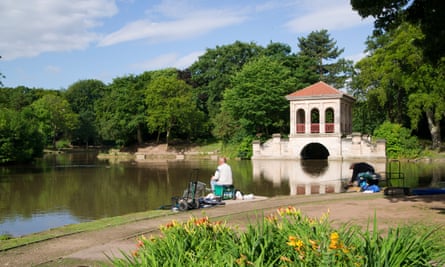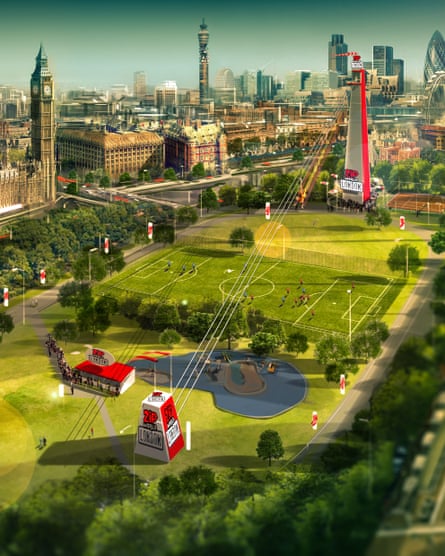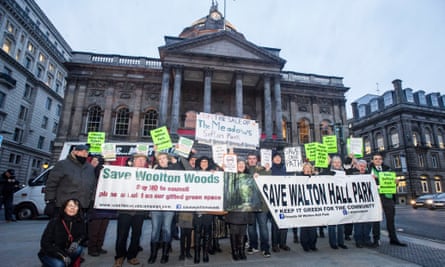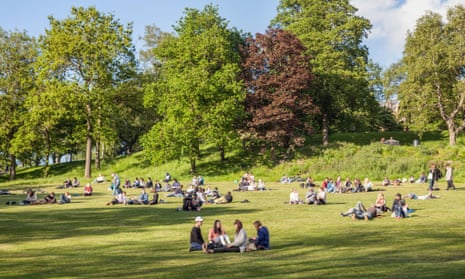We can expect, now that cracks are appearing in the government’s commitment to austerity, calls for many deserving causes to be released from their starvation diets. Of these, Britain’s parks and green spaces have been among the most viciously cut. They cost little in relation to their benefits. They are also assets for the long term, representing years and decades of investment that will be lost if they are degraded or, as is happening in some cases, sold off or built over. If, as David Cameron says, the point of austerity is to give future generations protection against future hard times, it makes no sense to throw away things of lasting capital value. Once gone, they won’t come back.
For who could not want parks? Who could not want their freedoms, their solace, their greenery and fresh air, their beauty, their opportunities for conviviality and solitude, their democratic indifference to class and wealth, the glimpse of nature they offer in hard cities? Playing in the park is a central part of urban childhoods, the stuff of memories and children’s stories. What could be wrong with what the Danish architect, town planner and writer Steen Eiler Rasmussen found in British parks – the “raw sensation of the elements” and their ability to free the mind? “How valuable it is,” he wrote, “to have access to the wonderland of an unrestrained imagination.” Henry James called them “an ornament not elsewhere to be matched”.
Who could not be grateful to the Improvement Commission of 1841, which created Birkenhead Park in the Wirral, the world’s first publicly funded civic park? Or to the Victorian campaigners who fought to preserve common land from developers or to the local authorities that acquired and maintained green spaces in towns and cities or the benefactors who endowed them?
Parks are good for bodily and mental health. They help in the fight against obesity. They are good for biodiversity and lower city temperatures in the summer. They are free, where other ways of entertaining your family are not – whatever savings might be made to taxpayers by cuts to parks will be spent several times by those same citizens on other distractions. As major cities become more populated and as rising property prices mean fewer people can afford houses with gardens, they are becoming more vital. They are incredibly good value: the National Federation of Parks and Green Spaces estimates that the combined local authorities’ expenditure on open spaces in England, Scotland and Wales is about £1.2bn per year, or 0.15% of total public expenditure.
They give benefits worth many times that: according to research by City of Edinburgh council, they return £12 in social, environmental and economic benefits for every £1 invested. They are popular and getting more so: 57% of the population visit a park at least once a month and the numbers are rising. They are good – if your pinched soul cares for nothing else – for property values. Almost everybody would want them to thrive, except maybe those so satisfied with their own garden or estate that they don’t care about those who don’t have them.
Yet Britain’s parks are now facing their greatest dangers for a generation. Their maintenance budgets are being halved or worse. Local authorities, desperate to reduce their costs, are trying to exploit them with every commercial use they can think of, or offload their care on to the private sector, or on to friends’ groups and community associations little more able than the council to look after them on minimal budgets.
The consequences are that parks become shabbier, uglier, more badly maintained and, eventually, more dangerous. Drew Bennellick, the Heritage Lottery Fund’s head of landscape and natural heritage, says that local authorities are losing the skills of ecology, arboriculture, horticulture and landscape architecture, resulting in “random tree planting, a huge increase in herbicides, fountains being shut down, graffiti not being removed, mismatched street furniture and cafes being replaced by mobile food units”. He says that some maintenance contracts only allow 30 seconds to prune each shrub, so they are hacked into small spheres. “You end up with bare soil and a few shrubs in ball shapes,” he says.
Antisocial behaviour creeps in. Cycles of decline start, in which parks get nastier, so their users stop going, so they get nastier still. City-dwellers retreat more to their homes and their electronic screens, with terrible effects on health. Intrusive and inappropriate commercial uses colonise green space and disturb the lives of residents. Fees for sporting facilities – tennis courts and football pitches – go up. In the worst cases, public green space is sold off for development and lost for ever.
Last year, the House of Commons communities committee said that parks were at a “tipping point” and that “if the value of parks and their potential contribution are not recognised, then the consequences could be severe for some of the most important policy agendas facing our communities today”.
The Heritage Lottery Fund noted a growing gap between the rising use of parks and declining funding, a gap that “does not bode well for the future condition and health of the nation’s public parks”. The Commons committee also said that central government should provide “vision, leadership and coordination”.

To which central government only shrugs. Until June, there was a minister with responsibility for parks, one Andrew Percy MP. He didn’t seem to achieve much, but when I ask the Department for Communities and Local Government who can now speak on the subject, I am told there is no replacement and I am offered the Northern Powerhouse minister or the minister for local government. A week later, I am told that the latter, Marcus Jones MP, is in fact also the new parks minister, even though it is not among the 10 responsibilities listed on his official website.
Nor can he talk to me or respond to the committee’s call for vision, leadership and coordination. I am however told that “parks breathe life into our towns and cities and are spaces for the whole community to come together to exercise, learn and play”. Gee, thanks. The department then boasts of a £1.5m fund – a whole £1.5m! – to deliver 87 pocket parks. Finally, it says that councils have the “freedom” to spend their much-reduced funding on “meeting local priorities, including maintaining local parks”. As far as national government is concerned, in other words, it’s not their problem. They’ve outsourced it to local authorities.
This abnegation of responsibility is the reason why parks all over the country are degrading. Local authorities have had their budgets cut drastically. They have to maintain their statutory duties – to house the involuntarily homeless, for example – which means that everything else gets squeezed even harder. Looking after parks is not a statutory duty. So, even though their running costs might be less than half a per cent of a local authority’s budget, they get cut and cut again.
Bristol City council has announced that its expenditure on parks will be cut to zero in 2019. Newcastle has cut its parks budget by 90% over the past seven years. Liverpool is exploring the option of handing management of its parks to the private sector and is looking to raise money by selling pieces of green land for development. Sometimes, the motivation is not only to cut running costs but to raise cash for other parts of a council’s budget. The London borough of Bexley is allowing development on some of its urban open spaces. In Stockport, 70 homes are being built on part of a country park.
The first remedy that desperate councils turn to tends to be commercial activity: funfairs, concerts, food and beverage outlets, a Go Ape! treetop ropes course in Battersea, London, and the “biggest, fastest city zipwire in the world” in Archbishop’s Park, Lambeth, also in London. Bennellick says that “events in parks can be incredibly successful” and cites the success of Nottingham’s parks in working with business and community groups to raise funding from commercial uses. In surveys, 60% of park users were happy with more such activity. Christopher Woodward, of the Garden Museum in London, says: “You shouldn’t always be frightened of the private sector.” He points out that Vauxhall Gardens, which for two centuries were London’s most famous place of leisure, were private.
But commercial events can also trash the ecology, disrupt the peace and inflict crowds, litter and traffic jams on residents. “The local community is up in arms because they can’t go into their own homes,” is a typical comment. Things such as zipwires need intrusive steel structures 30m or so high. And these attractions are accessible only to people who can afford their prices – £124 for a family of four to experience Go Ape! or £78 for the zipwire.
Councils go to the private sector, both to run parks and exploit the commercial opportunities they offer. But the profit motive does not have the long-term wellbeing of natural assets at heart. Bennellick argues that, as well as creating those shrivelled shrubs, private contractors have no interest in the bigger picture. To maximise their environmental benefits, he says, parks need a strategic approach that considers them not in isolation but in relation to each other. There’s not much chance of this happening in a minimum-cost maintenance contract.

A good, or bad, place to see the future of British parks is Liverpool. This is a city which, under the mayor, Joe Anderson, is in the vanguard of trashing its heritage in the interests of property development. So it may not be surprising that the city should have tried to destroy Walton Hall Park, created as a public asset in 1934, the fourth largest park in Liverpool and an incalculable benefit for the 45,000 residents of adjoining wards, among them some of the poorest in the country.
The plan was to build a new 55,000-seat stadium for Everton FC, along with 30,000 square metres of retail and leisure space, 1,000 homes and a 150-bedroom hotel – not surprising, maybe, but still shocking, an act of thuggery against the values that have been making cities better places to live over the past century and a half. As well as its 130 acres of grass and mature trees, it has had Football Association training pitches for a while that the public can also use, as well as lakes and bowling greens.
It has only been saved by the determined efforts of resident Chrisie Byrne and other campaigners. Its transformation would, says Byrne, have been the largest loss of urban green space in Europe. Even so, it has suffered from cuts: where once it was tended by 15 staff working five days a week, she says, it now has the attentions of three staff, working twice a week. Elsewhere in the city, controversial plans to build on another green space, Sefton Park Meadows, seem to be in abeyance after intense opposition from both locals and the actor Kim Cattrall, who grew up nearby. Another park, Calderstones, has not been so lucky: permission has been granted to nibble at its edges with luxury homes. The council argues that the area under threat is not technically part of the park and therefore can be built on. But it looks like a park and feels like a park and, therefore, you would think it is a park.
Even though the worst destruction in Liverpool has been averted, it is the intent that is frightening. Until now, parks have been pretty much sacrosanct. You just don’t build on them unless to create structures that enhance them, such as cafes and bandstands. Many have covenants that protect them, but others, such as the Liverpool examples, don’t. And even covenants can be undermined by determined lawyers. Once they start being eroded – a bit of Calderstones, some green space in Bexley, some more in Stockport – a principle is breached and there is no guarantee where the destruction will stop.
Apart from commercialisation, outsourcing and selling off, local authorities also respond to cuts by passing responsibility to friends’ groups and community associations. And their motivation can indeed work wonders. After the collapse of the Everton proposal, the Friends of Walton Hall Park, chaired by Byrne, have supplemented the work of the council’s emaciated staff. The Friends have revived and transformed the park, clearing the lakes of algae, managing the new growth of trees, replanting, cleaning up and installing seats and litter bins. Their only assets are voluntary work, the fundraising of small sums – a few thousand here and there – donations of plants and cuttings from private gardens, energy and enthusiasm.
Bennellick cites Myatts Fields in south London as a park sustained by a “really good friends group”. In Sheffield, a social enterprise company, Green Estate, looks after a group of parks formerly run by the council. It has been going since 1998, set up in the aftermath of a previous round of cuts, in the 1970s and 80s. It takes care of Manor Fields Park and Sheffield Manor Lodge, about half a mile apart, and three pocket parks, all in one of the poorer parts of the city. They fund themselves through commercial activity: landscape services such as clearing Japanese knotweed or making and restoring ponds; venue hire; processing green waste and designing “pictorial meadows”. The parks themselves, with loose and abundant growths of wildflowers, feel both un-municipal and loved.
It is an undoubted success and other cities and towns want to do something similar. A modest, lottery-funded initiative, Rethinking Parks, has explored creative forms of management. Newcastle, with the help of the National Trust, is looking for a way to hand responsibility for all its green space to a charitable trust. Bristol is also looking at setting up a trust, which would raise money from alternative sources of funding, and is getting advice from Newcastle and the National Trust on the subject.

Clearly, every possibility has to be explored, but Sue France, CEO of Green Estate, is sceptical that organisations such as hers can be the magic bullets they are now expected to be. There is only so much business that can be extracted from a single park, she points out, and only so much sweat, charity and goodwill that can be given by a community. This is particularly true of low-income urban areas that often need parks most: their citizens can’t splash out at high-priced cake sales, visit the commercial nurseries that a park might run or go to the concerts and funfairs. There are, she says, just “too many calls on their time and money”.
Hugh Holden, of the Bristol Parks Forum, doesn’t believe the city council will find, in the short time it has given itself, the £4.5m per year of alternative funding it needs. “You get to saturation point with events. There are only so many weekends during the summer,” he says. France says pretty much everything “has been tried by more or less everyone”. Initiatives such as Rethinking Parks “are going over the same old ground”. She also thinks it would be harder to set up an initiative such as Green Estate now, because it needed a level of expert assistance from the officers of Sheffield City council that local authorities now lack.
We have been here before. As the National Federation of Parks and Green Spaces puts it: “Similar policies and cuts were seen in the late 1970s and 1980s and most urban green spaces gradually but inexorably slid into decline over the next 10-20 years. Indeed, many, if not most, became unsafe, problem spaces plagued by neglect, vandalism and antisocial behaviour.” It took many years and considerable public investment, including £800m of lottery money, to retrieve them. The likelihood is that the investment, skills and effort will be wasted and the parks will go back to a worse place than they were then. “I’m depressed,” says France, “that we’re going to go through that whole cycle again.”
Strangely, given the importance of this collective national treasure, there’s not much by way of powerful national organisations to fight for their interests. There are valiant voluntary bodies such as National Federation of Parks and Green Spaces, the Parks Alliance and the 90-year-old Fields in Trust, but they don’t command public attention as they should. The Heritage Lottery Fund, whose primary concern is not green space, finds itself one of its principal champions, by virtue of the amount it has invested.
In the end, however much ingenuity is expended on new forms of management and funding, parks are public assets that require public money. The National Federation of Parks and Green Spaces believes that the current expenditure of £1.2bn per year should be more like £2-3bn. It is asking, in other words, for about as much in additional funding as is going on the notorious bung to the Democratic Unionist party.
It might also help, as a number of campaigners have argued, if care of parks became a statutory duty for local authorities. In this patriotic Brexit era, when Britain is learning to again stand strong and alone, parks are a British achievement and asset to be proud of, imitated and envied across the world. If national government had the decency even to notice that they are under threat from their policies, it would be a start.
My favourite park: writers’ green spaces

Robert Macfarlane
Parker’s Piece, Cambridge
The room I’ve worked in for the past 12 years overlooks Parker’s Piece. It’s my daytime TV: I watch it from my desk. I’ve seen everything there: an attempted murder, a red kite, Lord of the Flies-style schoolkid scraps. On a winter’s day, filled with walkers, it looks like a Lowry painting: all those slender upright figures spread out across its space. Most of all, though, I associate it with happiness: hundreds of people lying out on hot days, couples kissing as though the rest of the universe didn’t exist, games and laughter for centuries of townspeople.

Geoff Dyer
Hyde Park, London
In every aspect of life, I love things that combine functionality and beauty. Hyde Park is one of the wonders of London in this respect. Even when you’re just cycling through it as a rural shortcut in the middle of the city you’re struck by its abundant loveliness. In transit, in any season, the park continually displays its status as destination. Make that destinations, plural, since there are numerous quite distinct zones, some cultivated, some sufficiently wild that it can seem as if you’ve stumbled into some mythic essence of England.

Kirsty Wark
Howard Park, Kilmarnock
We need parks to stay free for everybody’s health – they act as a lung in cities and towns. They also act as a gathering place, which gives children freedom but within parameters. As a child I would go to Howard Park during the holidays, often at nine in the morning, and explore it with my friends. You’d have a packed lunch and you wouldn’t go home till teatime. The more we cover over parks, the less chance our children will have to explore.

Will Ashon
Epping Forest, London
Epping Forest is the flipside of the Victorian mania for public spaces – not the neat and orderly rationality of municipal gardens, but a darker, more complex resource, a giant hideout into which you plunge and immediately find yourself lost. I’ve been wandering through different parts of the Forest since I moved to Walthamstow more than 15 years ago, and its key pleasure lies in leaving the path – there’s no trespassing in here, so it’s important to make the most of your rights by crashing through the undergrowth and discombobulating both yourself and the wildlife. It’s a place of huge symbolic resonance, too – 140 years after this Forest was saved from Enclosure we need to resist all further attempts to privatise our common inheritance.

Nikesh Shukla
St Andrews Park, Bristol
St Andrews Park is Bristol to me. As dub throbs from Minirigs, as the smell of barbecue hangs low under the trees, as the circus guys practise tightrope, as the skateboarders do stunts, as the kids of ex-Londoners run wild, I walk loops around and through the park, trying to get my first daughter to sleep, then to practise on her balance bike, then to get my second daughter to sleep. I have walked every inch of this park, many times a week, many times over, and it never gets boring, because it has become like my garden, part of my home. I have listened to audiobooks, podcasts, the entire discography of the Wu-Tang Clan and its solo members and various affiliates. I have drunk the milky coffee from the tea hut. And while the dub and the barbecue and the circus guys and the skateboarders and the ex-Londoners all seem like Bristol cliches, I’m thankful for them. In this park, I finally feel like this city is my home.

Emma Jane Unsworth
Heaton Park, Manchester
I used to go every week with my sister and my dad to climb the trees and sit on the lion statues outside Heaton Hall. It was sold to the council by an earl in the early 1900s and that’s the way these things should work. Without Heaton Park, my childhood would have been a lot less adventurous, a lot less green. When I moved away I got a photo of one of the lions tattooed on my arm. It’s a good likeness, down to the slightly eroded back, worn down by decades of children’s bums.

Matt Haig
Hyde Park, Leeds
Hyde Park sits on top of a hill next to the university in Leeds, easily walkable from the city centre. It is a large, expansive city park full of students and locals and joggers. When I was ill with anxiety I used to run around it six times every Sunday morning. Then, later, it would be the place I’d gravitate to in breaks from writing. A calm green space of the mind as well as the city, which was a sanctuary when I lived there, and where I’d often get ideas for novels. I still go back there whenever I’m in Leeds.

Scroobius Pip
Kelsey Park, Beckenham
A park comes straight to mind. When I was a kid my nan used to take me to Kelsey Park. It was a magical place for me. The squirrels would come up and eat from your hand and the trees were twisted and mysterious. But, best of all, due to one half being sectioned off as “no dogs allowed”, you could watch said dogs look angrily across the pond at the local cats, having hopped the fence from the houses backing on to the park, lounging in the sun without a care in the world.

Travis Elborough
Victoria Park, London
Victoria Park was London’s first purpose-built public park and it fulfils that almost Lubetkin idea of “nothing is too good for the common people”. I use the park for strolling, for moments of quiet contemplation, for reading and people-watching. There’s this duality about parks – despite the fact that they’re public, you can be private; they’re communal as well as solitary. I go to both Clissold Park and Butterfield Green, down the road from me, to get away from my desk, but there’s a bitter irony in writing a book about parks; in a way you’re taking your desk with you, because everything is material.










Comments (…)
Sign in or create your Guardian account to join the discussion